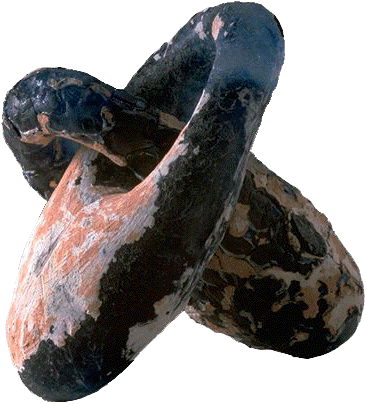

Many years later, during my art studies in California, I started to incorporate my memories from this valley into my art work. I began to make works based on tools that these people used in their daily life. I used to find parts and pieces of these tools as I was digging in the coarse ground for soil to bring to my mothers tree planting effort. As a kid, I kept these parts in containers, or hung them up on the wall in my room and wondered what they might have been used for. In California, thousands of miles away, and years later, I felt I needed to understand the link between myself and my ancestors. I asked my parents and relatives to tell me stories about what it was like, and started reading about ancient Icelandic tools and how and where they were used. What I learned, about my relatives, was that most lived uneventful lives in very harsh living conditions and the average life span was very short. This explained why the tools that I found during my explorations were in such bad condition, and had often been altered from their original shape. These people had to be inventive. modifying tools that they could buy, or figuring out how to make them, then fixing them when they broke.
These tools were my main physical link to the past. To better explore my origins, I began to alter the way I made my sculptures. I began to find ways to reuse materials that I saw others throw out. If the piece broke while I was creating it, I stopped and tried to put myself in the shoes of my ancestors to try to see how they might have solved a similar problem. Remembering repairs that I had seen on old tools, I would apply the same philosophy to my pieces. My sculptures began to reference old tools used in farming and fishing. But their functionality would not be evident, just as the tools that I found in the past were a mystery to me. Keeping with this philosophy, the material in the pieces had to be second hand, found, or be destined for the trash bin. I would visit recycling centers, local companies or artists to acquire raw material. I would get window glass from recycling centers, colorful cut-offs from glass art studios, clay trimmings from local artists, ceramic glazes from garage sales, and so forth.
I would certainly not have taken this direction with my work had I stayed in Iceland, to complete my art education. The ideology of California in general, and the Bay Area in particular, affected my thought process in ways that only recently are becoming clear to me. Values of diversity and cultural heritage were integrated into the curriculum, and the community emphasized recycling and nature preservation. Within this framework, I thought back to the situation in Iceland, and was awestruck by how resourceful my ancestors had been in eking out a living, and how wasteful the current generation had become. From everything I observed, the same development had occurred in the US. Changing the world begins with yourself, so I reduced the amount of new raw materials in my work. Today, my work is created completely from reused materials. My point is not to make a statement about how much modern society throws away. The point is that the raw material can be reused; using it for a certain function does not stop it from being re-molded and recast as something else.
Today, the "tool look" from my early work is not as evident. I don't feel that I need as much that link to the past anymore. The theme of my work is inspired from my surroundings and events in my life. Moving from California to North Carolina, establishing connections in a new place, giving birth to my three children, illnesses. interesting news etc. are aspects in my life from which I currently draw inspiration. The materials used in the pieces, and how they are created, is very similar to what I did with the "tool" pieces, except for continuing refinement of the technique.